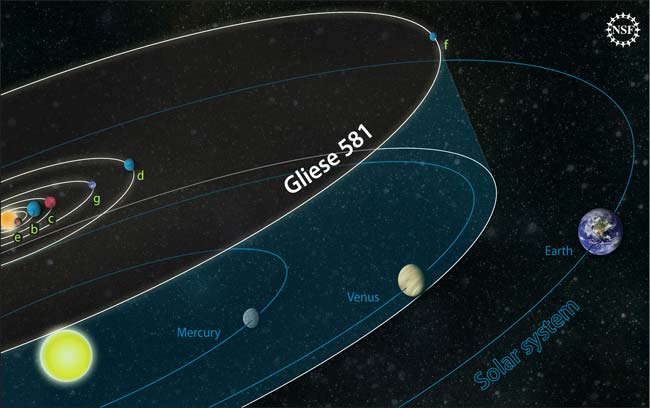Planet Gliese 581d Star's Habitable Zone Explained

Where there's water, there's the possibility of life. It just so happens that H2O acts as an ideal medium for chemical reactions between organic molecules, helping them link together to form amino acids — the building blocks of proteins, and thus, cells.
For this reason, the "habitable zone" around a star, the zone in which there could be life, is the range of distance in which planets can maintain liquid water on their surfaces. [What Are the Ingredients of Life?]
Gliese 581d, an exoplanet (planet outside our solar system) seven times the size of Earth, orbits a star called Gliese 581 that is 20 light-years away in the constellation Libra.
When it was first discovered in 2007, Gliese 581d was thought to be just outside its star's habitable zone, but later, scientists discovered that Gliese 581d is just close in enough to potentially sustain liquid water. It "could even be covered by a large and deep ocean," one of its discoverers, astronomer Stephane Udry of the Geneva Observatory, said in 2009. "It is the first serious 'water world' candidate."
Now, further analysis suggests that not only is Gliese 581d in the habitable zone, it might even have a dense, stable atmosphere suitable for life.
Researcher Robin Wordsworth and her colleagues at the Institute Pierre Simon Laplace constructed computer simulations to study the climate on Gliese 581d in a similar way as atmospheric scientists model climate patterns on Earth.
Wordsworth's simulations "demonstrate [Gliese 581d] will have a stable atmosphere and surface liquid water for a wide range of plausible cases, making it the first confirmed super-Earth (exoplanet of 2-10 Earth masses) in the habitable zone," she writes in a new study detailed in the journal Astrophysical Journal Letters. [Video: Life-Sustaining "Super Earth" Gliese 581d]
Get the Space.com Newsletter
Breaking space news, the latest updates on rocket launches, skywatching events and more!
Planets in a star's habitable zone are often called "Goldilocks planets." They aren't too hot, causing water to boil away, or too cold, causing it to freeze; instead, they're just right for liquid water and the life that could arise in it.
Earth, for example, is nicely situated in our sun's habitable zone, which starts about midway between Earth and Venus and extends nearly to Mars.
In the future, more detailed observations of the light spectrum coming from Gliese 581d will help researchers figure out whether the exoplanet's atmosphere is composed of the same greenhouse gases as Earth's, such as carbon dioxide, or whether it is made of lighter elements such as hydrogen and helium. The latter type of atmosphere wouldn't shield the planet from the star's high-frequency ultraviolet light, and so wouldn't be as conducive to life.
This article was provided by Life's Little Mysteries, a sister site of Space.com. Follow Natalie Wolchover on Twitter @nattyover.
Join our Space Forums to keep talking space on the latest missions, night sky and more! And if you have a news tip, correction or comment, let us know at: community@space.com.

Natalie Wolchover was a staff writer for Live Science and a contributor to Space.com from 2010 to 2012. She is now a senior writer and editor at Quanta Magazine, where she specializes in the physical sciences. Her writing has appeared in publications including Popular Science and Nature and has been included in The Best American Science and Nature Writing. She holds a bachelor's degree in physics from Tufts University and has studied physics at the University of California, Berkeley.










